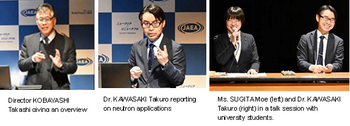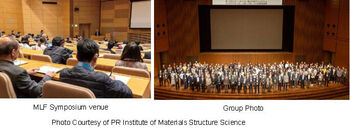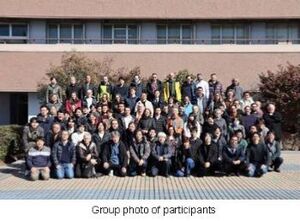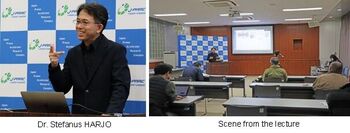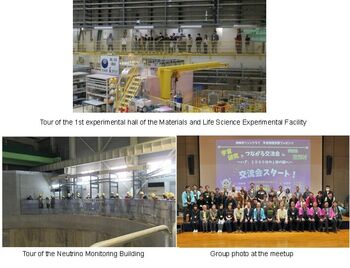J-PARC News March 2025 (Issue #239)
■Discovery of the First High Oxide Ion Conductor Rb5BiMo4O16 Containing Rubidium
- New Applications and Markets for Rb; Low-Temperature Operation and Low-Cost Solid Oxide Fuel Cells -
Oxide ion conductors are materials that have a wide range of applications in solid oxide fuel cells, oxidation separation membranes, catalysts, and gas sensors. However, the materials currently used have high operating temperatures and there are problems with manufacturing cost and stability, so there is a need for oxide ion conductors that exhibit high conductivity and stability at medium to low temperatures, 300 to 500 degrees Celsius.
Since Rb ions are the second largest cation in size among the available cations, Professor YASHIMA Masatomo and his research group at the Institute of Science Tokyo searched for oxide ion-conducting rubidium (Rb)-containing oxides. Through screening of 495 Rb-containing oxides, sample synthesis, sample properties, and evaluation of transport properties, they discovered the palmierite-type Rb5BiMo4O16, which was found to have high oxide ion conductivity. In addition, in collaboration with Prof. MORI Kazuhiro at KEK/J-PARC, they conducted neutron diffraction experiments using SuperHRPD at MLF at J-PARC and further clarified the cause of the high oxide ion conductivity by first-principles molecular dynamics simulation.
The Rb5BiMo4O16 discovered in this study has the potential to open up new Rb applications and markets and is expected to make a significant contribution to future decarbonization efforts.
■Development of a lightweight shape memory alloy that exhibits superelasticity even at temperature changes of 400℃.
- Expectations for use in space environments and biological applications -
Shape memory alloys have been used in a wide range of products, including eyeglass frames and medical devices. However, these alloys cannot be used in extreme conditions, such as space exploration and hydrogen environments, due to the narrow temperature range in which the shape memory effect occurs.
In this study, a new lightweight shape memory alloy (Ti-Al-Cr) was developed, primarily composed of the lightweight elements titanium and aluminum, with a small amount of chromium added. This alloy exhibits excellent superelastic properties over a wide temperature range of about 400℃, from -269℃ to +127℃. The deformation mechanism of this alloy was investigated using "SENJU", the extreme environment single crystal diffractometer, and "TAKUMI", the engineering materials diffractometer at MLF in J-PARC.
The developed alloy is lighter than existing shape memory alloys and can be used in a wider temperature range. In addition, being a titanium-based alloy, it is considered to have high corrosion resistance and is expected to be applied to space exploration. It is also expected to contribute to the realization of a hydrogen society through its application as a low-temperature sealing material, and to biomaterials by utilizing its superelastic properties.
■Recent awards
Received KEK Technology Award (February 17th)
Dr. OHSHITA Hidetoshi of the Neutron Instrumentation Section received the KEK Technology Award for his presentation 'Precise Measurement of Neutron Counts with Nitrogen Gas-Filled Neutron Beam Monitors at the MLF in J-PARC" and an award ceremony and lecture to mark the occasion were held on February 17th.
Dr. OHSHITA proposed a method for monitoring the neutrons incident on the neutron instruments constructed at MLF as a steady-state absolute quantity and started its operation in actual experiments. The measured absolute neutron flux is consistent with previous studies and is expected to be used for the analysis of experimental data and long-term monitoring of the neutron source condition.
On receiving the award, Dr. OHSHITA expressed his gratitude, saying, "I would like to thank everyone involved for their support in helping me to receive this award. I am also very happy that the people who have helped me so far are even more pleased than I am to receive this award." He commented with a smile.
■19th Tokai Forum Held (February 19th, Tokai Cultural Center)
This annual event has been held jointly by the Nuclear Fuel Cycle Engineering Laboratories, the Nuclear Science Research Institute and J-PARC to deepen understanding of the activities of the Japan Atomic Energy Agency among residents. This year's event attracted 125 visitors, with a record 198 people registering online.
Director KOBAYASHI Takashi gave an overview of J-PARC. Dr. KAWASAKI Takuro of the Neutron Science Section presented the elucidation of the mechanisms of strength and deformation in structural materials using neutrons.
This time, a talk session was held between the speakers and university students living in Ibaraki Prefecture, with Ms. SUGITA Moe of the Accelerator Section Ⅳ serving as moderator. In the questionnaire, we received comments such as "I learned that nuclear power is more involved in our lives than I thought." and "The panel discussion with university students was good and new." We will continue to make efforts to promote understanding of our activities in the local community.
For more information, please visit the website of the Nuclear Fuel Cycle Engineering Laboratories (written in Japanese).
https://www.jaea.go.jp/04/ztokai/forum/index.html
■The International Advisory Committee (IAC2025) was held (February 24th and 25th)
Based on the "Fundamental Collaboration Agreement Regarding the Management of High-intensity Proton Accelerator Facilities," the international Advisory Committee is for external members to discuss important matters related to the operation, utilization and maintenance of J-PARC. All 16 committee members (12 from overseas and 4 from Japan), including the chairperson Robert McGreevy (Science &Technology Facilities Council, U.K.), attend the meeting. They discussed R&D activities at J-PARC in FY2024 and made recommendations for the following fiscal year and beyond.
In the parallel session, young researchers, who will be responsible for the future development of J-PARC, reported their recent R&D activities. In the reception held in the evening, Mr. YAMADA, Mayor of Tokai Village, Dr. MICHIZONO, Executive Director of KEK, and Dr. MONMA, Executive Director of JAEA, attended the reception and frankly exchanged their views on the future of J-PARC.
On the last day, a tour of the maintenance area of MLF, the South Experimental Building of the Hadron Experimental Facility, the Monitoring Building and the Assembly Building of the Neutrino Experimental Facility was conducted.
■2024 Quantum Beam Science Festa to be held at Tsukuba International Congress Center (March 12th-14th)
- The 16th MLF Symposium and the 42nd PF Symposium -
The Quantum Beam Science Festa (QBSF) is a forum for exchange between the Photon Factory (PF) at KEK and the Materials and Life Science Experimental Facility (MLF) at J-PARC. It is held alternately in Tsukuba and Mito to encourage researchers using probes such as synchrotron radiation, neutrons, muons and positrons to discuss the future of quantum beam research. This year, 565 participants (including 142 students) gathered at the Tsukuba International Congress Center.
On the first day, the MLF Symposium was held, where reports and results from the facility were shared, and there was a fruitful discussion about plans and facility use. During the symposium, the general meeting of the MLF Users' Society and a session for requesting improvements to the MLF were also held, and it was shown that the users' requests were being considered by the MLF to be realized. On the second day, the Quantum Beam Science Festa was held, with 276 poster presentations. There were 75 entries for the Student Encouragement award, and three from the MLF won the award. On the third day, many people involved with the MLF also attended the PF symposium, as a consequence of the deepened relationship between the two facilities.
■Hyper-Kamiokande Collaboration Meeting (February 17th-22nd)
Approximately 600 researchers from 22 countries are participating in the Hyper-Kamiokande International Research Collaboration. Construction is underway intending to start the experiment in 2027, and the world's largest giant underground cavity is currently taking shape in the Kamioka Mine, Hida City, Gifu Prefecture.
In order to collaborate on various issues toward the completion of this detector, about 120 members from overseas and Japan gathered at the AYA'S LABORATORY Quantum Beam Research Center (AQBRC) to work together for this meeting, where very active discussions were held with remote connection participants. During the conference, a tour of the J-PARC beamlines was conducted, and a visit was also made to the planned construction site of the Intermediate Water Cherenkov Detector IWCD at Tokai Village.
■Hello Science "Observing stresses in metals" (February 28th)
Dr. Stefanus HARJO of the Materials and Life Science Division introduced his research on the stress remained in metallic materials and components, as well as studies using the engineering materials diffractometer "TAKUMI" at J-PARC.
Metals experience various stresses in daily life, such as temperature changes, corrosion and repeated bending and tension. These stresses cause changes in the arrangement of atoms (crystal lattice), affecting properties such as strength, ductility and durability. By using neutron diffraction with TAKUMI, real time observation of changes in the crystal lattice of metals under stress is possible. This technology aids in elucidating the mechanisms behind the strength and functionality of various metal materials and components. It has contributed to numerous technological innovations and the development of new materials, such as developing high-performance shape memory alloys and improving the strength of reinforced concrete.
Dr. HARJO will continue to advance research in materials engineering with TAKUMI, leveraging its capabilities alongside the expertise of a skilled craftsmanship team.
■Exhibited at the Sakurie Science Festival (March 15th)
The Sakurie Science Festival was held at the Hitachi Civic Center Science Museum with the theme of "Let's have lots of fun with science and learn to love it even more!" The J-PARC Center held a hadron accessory class, a cloud chamber class, and a superconducting coaster demonstration. The hadron accessory class was so popular that numbered tickets for the class were sold out in no time after the opening of the museum. In the cloud chamber class, all participants were able to observe radiation trails. The superconducting coaster booth also attracted many visitors, from preschool children to adults, who tried out the experiments, floating or sliding the superconducting coaster along the magnetic track.
◆ Demonstration of a superconducting coaster
◆ Hadron Accessories Workshop
◆ Cloud Chamber Class
■J-PARC Visiting Lectures
(1) Takuma Campus, National Institute of Technology, Kagawa College, (February 18th)
Dr. OTANI Masashi of the Accelerator Division gave an online lecture titled "The Mechanism of Accelerators that View the Microscopic World: Muon Accelerator Technology that Views Everything from Elementary Particle Phenomena to Giant Structures" at Takuma Campus of National Institute of Technology, Kagawa College. Dr. OTANI has succeeded in accelerating elementary particle muons for the first time at J-PARC and is using the accelerator to explore the mysteries of muons, while also developing new inspection technology using the accelerated muon beam.
In the lecture, he explained the structure and principles of accelerators and, as an example of their use, he introduced medical applications, which are of great interest to students. Furthermore, he introduced industrial applications of muons, such as research into the interior of ancient pyramids and magma in volcanoes, and the commercialization of a device to monitor contraband in containers at ports, making use of the penetrating power of muons. In the last part of the lecture, Dr. OTANI, who is a graduate of a technical college, introduced his own experiences in social cooperation projects, the production of a small accelerator, ~AxeLatoon,~by students at the technical college.
In the post-attendance questionnaire, we received comments such as "I would like to know more about the mechanism and origins of accelerators," "I would like to hear more about why you studied accelerators and the interesting aspects of accelerators," and "I would like to hear about simulations of accelerators.
(2) Katsukura Elementary School, Hitachinaka City (February 26th)
Dr. MIBE Tsutomu of the Hadron Section gave a special class on "How to make a mysterious top that tilts but doesn't fall over⁉.
He asked the students questions such as "What is the smallest thing in the world?" and "What is made a lot in Ibaraki Prefecture? ".
He explained that J-PARC is a facility where they study elementary particles by creating lots of them. Although they are so small that they are invisible to the eye, they move like tops. The sixth graders observed the rotation of the axis of the Gyroscope, and each made their top and conducted an experiment to change the direction of the rotation of the axis by changing the center of gravity of the top.
■J-PARC Sanpomichi 56 - The World Connected by Neutrinos Hida and Tokai residents get to know each other - 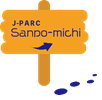
Neutrinos generated at J-PARC in Tokai Village, Ibaraki Prefecture, reach Super-Kamiokande in Hida City, Gifu Prefecture, 295 km away, in just 1/1000 of a second. The people of Hida City came to Tokai Village by sightseeing bus, taking 7 hours each way. Twenty people visited the MLF Experimental Hall and the Neutrino Monitoring Building at J-PARC, and a meetup was held in the evening with 30 people from Tokai Village. This is the first time that such a large exchange has been held between the citizens of Hida and Tokai.
During the tour and discussion, it was clear that many people are interested in and support the T2K experiment, which is connected by large research equipment on both sides. Some of the participants had come from Kochi Prefecture.
When electricity was invented a long time ago, nobody expected communication technology to develop as much as it has. Television and telephones are now common, and the Internet lets us share knowledge and thoughts with people around the world instantly.
At the moment, we are not sure how neutrinos will benefit society. Nevertheless, it is clear that people are gradually becoming more connected through neutrino research.


